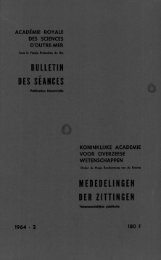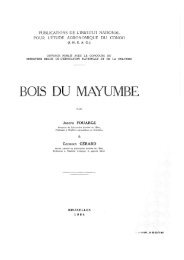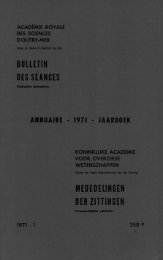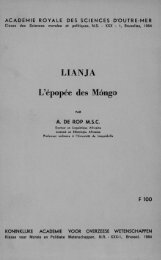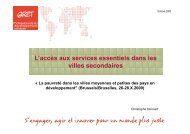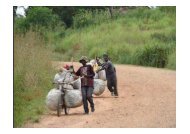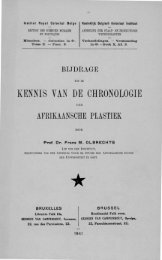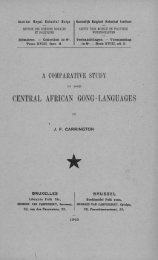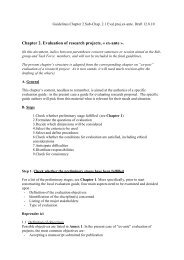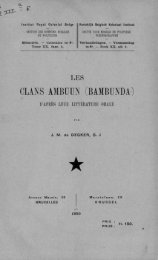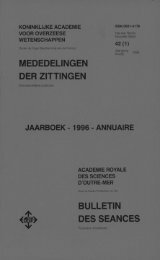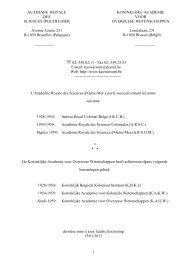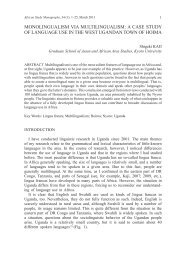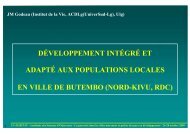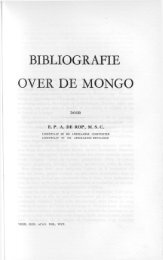KONINKLIJKE ACADEMIE VOOR OVERZEESE WETENSCHAPPEN ...
KONINKLIJKE ACADEMIE VOOR OVERZEESE WETENSCHAPPEN ...
KONINKLIJKE ACADEMIE VOOR OVERZEESE WETENSCHAPPEN ...
Create successful ePaper yourself
Turn your PDF publications into a flip-book with our unique Google optimized e-Paper software.
— 281 —<br />
— The fish biological characteristics including fish nutrition, fish growth and<br />
reproductive biology;<br />
— The maturity period of the broodstock maintained in pond;<br />
— The possibility of artificial propagation by using different hormone stimulations;<br />
— The possibility of rearing fingerlings and promoting intensive growing-out in<br />
earthen ponds;<br />
— The household income for farmers in the Mekong Delta.<br />
The results were very good and climbing perch is now one of the most important<br />
cultured fish in almost all the provinces in the Mekong Delta, south of<br />
Vietnam.<br />
2.1. E x pe r im e n t a l M a te r ia ls<br />
2.1.2. Site for Research Activities<br />
2. Materials and Methods<br />
Research was conducted at the experimental fish hatchery station, Department<br />
of Freshwater Aquaculture, College of Aquaculture and Fisheries Sciences, Can<br />
Tho University, with the help of the Unité de Recherche en Biologie des<br />
Organismes (URBO), Facultés Universitaires Notre-Dame de la Paix (FUNDP,<br />
Namur, Belgium) and in partnership with the cooperative farmers in Long an,<br />
Can Tho, Kien Giang, An Giang, Dong Thap and Vinh Long provinces in the<br />
Mekong Delta. The research on artificial propagation and intensive culture of<br />
climbing perch includes three steps: three main experiments.<br />
2.1.2.1. Experiment 1: Artificial Propagation of Climbing Perch<br />
— Climbing Perch Brood Stock Culture for Maturation<br />
A wild brood stock of climbing perch was collected from An Bien district,<br />
Kiengiang, An Giang and Can Tho provinces. Seven to ten fish/kg were cultured<br />
in plastic cages of 2 x 2.5 x 2 m, at stocking density of 5 kg/m3. The brood stock<br />
was fed with 30-32 % protein food at a feeding rate of 1.5-2 % of total fish body<br />
weight per day.<br />
— Artificial Propagation of Fish<br />
Hormones as Human Chorionic Gonadotropin (HCG), Lutein Releasing<br />
Hormone (LHRHa) + Domperidon (DOM) and pituitary gland of common carp<br />
(one unit of pituitary common carp = 0.05 mg) were used at different concentration<br />
levels (tab. 1) to produce eggs of climbing perch (K ie m 1999).<br />
Only one injection of hormones was used to stimulate artificial spawning, but<br />
the concentration levels of hormones for male were equal to 1/2 to 1/3 hormone<br />
concentration level for female. Male and female ratio was 1:1.



